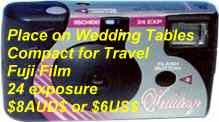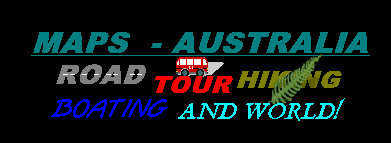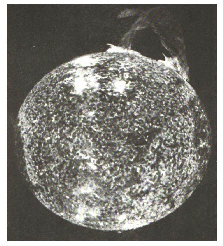
SUN
VENUS TRANSITS THE SUN
JUNE 2004
121 YEARS SINCE LAST VENUS TRANSIT

Photo taken by our Disposable Camera
Thanks to those who attended Glenelg for the Venus Transit. We hope you enjoyed a once (maybe twice) in a lifetime phenomena
ITEMS FOR TRANSIT
VENUS TRANSIT INFORMATION
WHAT'S HAPPENING
Astronomical Transit - "the passage of a smaller celestial body or its shadow across the disk of a larger celestial body."The Planet Venus will Transit across the face of the Sun. The event can be witnessed by using the appropriate Sun Filter on Binoculars or Telescope, or the technique of Solar Projection.
If you have good sight, then normal Eclipse Glasses will surfice.
*NEVER LOOK AT THE SUN WITHOUT THE APPROPRIATE SOLAR FILTER*.
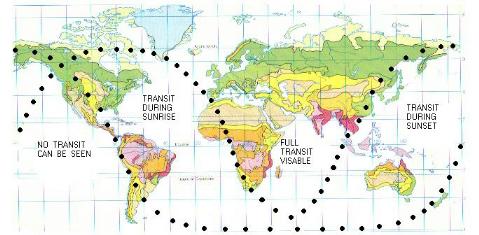
WHERE'S IT HAPPENING
Venus follows the same path as the Sun and Moon across the sky. Since Venus's orbit is closer to the Sun than ours (inferior planet), the planet can be generally seen at dawn, dusk or twilight and is the brightest object in the sky except for the Moon. Venus itself, cannot be seen during the day since the Sun is too bright. The Transit time will depend on your location. Please see Diagram above and information below:WHERE CAN I SEE IT FROM?
Part or all of the Transit can be seen from just about any location on the Earth. Unfortunately, some places will not be in a position to see it. These include New Zealand, Fiji, Tonga, Hawaii and Western parts of the Americas.WHEN'S IT HAPPENING
The Transit will last more than 6 hours from start to finish. On the 8th of June at 05:08 UT (Universal Time) the Transit will begin. Local times are below:- Perth, Australia 1:09pm *Correction Made*
- Adelaide, Australia 2:37pm
- Sydney, Australia 3:07pm
- Auckland, New Zealand. *Can't be seen*
- California, USA 7 hours behind UT eg. 05:08 UT - 7 hours = 22:08pm. *Can't be seen*
- New York, USA 4 hours behind UT
- Rio de Janeiro, Brasil 3 hours behind UT
- London, England 0 hours
- Cape Town, South Africa 2 hours ahead
- Hong Kong, China 8 hours ahead
FIND YOUR CITIES' UNIVERSAL TIME
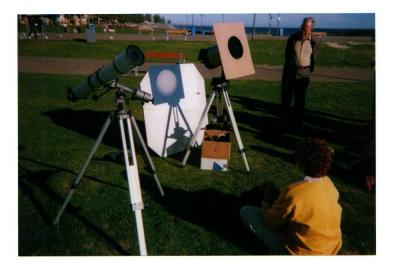
The Transit will be best seen through a pair of Binoculars or Telescope using the appropriate Solar Film, Wielding Glass No. 12 or stronger, or via Solar Projection. The Transit can be seen using Eclipse Glasses under good conditions (high in the sky) with good eyesight. The disk of Venus will be 1/32th the diameter of the Sun. As the Sun gets lower in the atmosphere, it will be harder to observe unaided.
SAFETY
- Looking at the Sun even for a few seconds can cause irreversible damage.
- Using filters in the eyepiece are dangerous because the heat is concentrated on the eyepiece. One crack....
possible blindness.
Please Note:
*The Appropriate Solar Filter still needs to be used for this technique.*
*Ensure Any Caps Made are securely attached to the Telescope and cannot be blown or knocked off*
*Always Cover the Finderscope to prevent accidental blindness* - To align the Telescope with the Sun, look at the Telescope's Tube shadow on the ground and adjust so the shadow is perfectly round (outside of tube).
Solar Filter caps which fit over the end of your telescope are available. Let us know your telescope diameter.
Solar projection onto a piece of cardboard or similar is a good way to view the Transit and Sun Spots. If your using a large reflecting telescope, only use a small hole to gather the light. A cheap eyepiece like Huygen (Hoi-gen) or Ramsden is best. They do not use glue to hold the lenses together inside the eyepiece (it will melt!). We have them available.
Remember to place a filter over the finderscope of your telescope or block it off all together to prevent eye damage from the curious wondering what your looking at. Also, the finderscope can cause a burn and in some plastic cases - melt!
STOPPING DOWN A TELESCOPE
Please Note:
*The Appropriate Solar Filter still needs to be used for this technique.*
*Ensure Any Caps Made are securely attached to the Telescope and cannot be blown or knocked off*
*Always Cover the Finderscope to prevent accidental blindness* - To align the Telescope with the Sun, look at the Telescope's Tube shadow on the ground and adjust so the shadow is perfectly round (outside of tube).
Increased clarity, along with a longer focal ratio, decreased brightness and the ability to use the best part of your mirror is some of the advantages of Stopping Down a Telescope.
Disadvantages are a reduced Field of View.
Cut out a cardboard or similar disk about the same diameter as your tube. This will be placed over the end of the telescope (where the light goes in). From the disk, cut holes in the places where only the mirror sees (no obstruction). eg. between secondary mirror arms, around the secondary mirror, or even if your focuser sticks in too far creating an obstruction. Keep the cornering of the circles neat. Oblongs are ok. Each hole is now your mirror without the obstruction of the secondary mirror, arms and maybe focuser which steal resolution. Your new size mirror changes the focal ratio of the telescope to a longer one making it great for Moon, planets and Transits - as long as the subject is bright enough for you now, smaller mirror. Using circles in the disk makes it easier to work out your new focal ratio etc. Circles also allow you to choose what part of the mirror is used by rotating the disk.
MORE TRANSIT STUFF
INTERESTING EFFECT
As the black disk of Venus fully enters the Sun's Disk, a black trail appears to stay connected to the edge of the disk of the Sun. This lasts for a small period of time. The unexpected effect is liken to a drop of water clinging to a surface as it drops. This is also known as "teardrop". Another way of recreating the affect is to put your fingers together in front of your eyes. As the gap decreases, the edges of your fingers become blurred. Turbulence, the differences between light and dark and Venus' atmosphere, are amoungst the reasons thought to be causing this effect.THE RARE TRANSIT
On June 8th Venus will pass in front of the Sun. The event is very rare having last occured in 1882. There are always 2 transits of Venus relatively close to each other. The next being in 8 years.OBSERVABLE LOCATIONS
New Zealanders will unfortuneatly miss the event since the transition will start at sunset. As we move west, the event will start earlier in the day when the Sun is higher and easier to observe. Observers in Sydney will witness the start around 3.00pm. For observers in the middle of Australia (Adelaide), Venus will start its transition around 2.30pm. The entire event will be widely visible from the Europe, Africa and Asia. The transition will last for about 6 hours.EVENT SIGNIFICANCE FOR MEASUREMENT
Significance of the event include a determination of the Astronomical Unit (au). The Astronomical Unit is based on the average distance between the Earth and the Sun and is mainly used to measure objects in the Solar System.One way of measuring distances is to use Angular Measurement. One of the different ways of Angular Measurement is Triagulation Method. An observer can obtain the angle from the observed diameter of the object. Knowing the angle allows us to calculate the distance. While Venus transits the Sun, another measurement can be taken which is the diameter of the Sun. Having an extra measurement allows more accuracy as both measurements can be compared. eg. distance from Venus to Sun.
Observed diameters of objects are measured in Arc Seconds. An Arc Second is derived thus:
360° - (Circle)
Divided by 60 - (Minutes)
Divided by 60 - (Seconds) = Arc Seconds.
Venus will be around 58 Arc Seconds in diameter during Transit.
There will be many schools and organisations taking their own measurements. The Angular Mesurement taken by some will be by Secular Parallax. This basically uses measurements from 2 locations on the Earth to form a triangle to Venus. Since its been 181 years since the last mesaurement, we are certainly due for an update!
Data taken from the 1761 and 1769 Transits were not used until over a century later to determine the Sun's distance. This is because the technology of calculations had not yet been discovered. The measurement taken at that time is accurate to 0.1 percent. Other, more accurate means of measuring the average distance to the Sun have been used the since the last transit. Today's figure is 1,495,978,706,974 -/+ 0.0003km (accurate to 33cm)
INTERESTING HISTORY FOR AUSTRALIANS
When Captain Cook made his original voyage south in 1769, it was to observe the transit of Venus from Tahiti. The scientific importance of the transit was to use it to measure distances in the solar system. Captain Cook was specifically chosen because he was amougst the very few who knew how to work out longitude. Together with his seamanship, he was a particularly special person, and only he could have made the voyage. During the voyage, he opened his secondary secret orders which reveiled he was to discover the great southern land (Australia) and claim it for Britain.VENUS TRANSIT LINKS
Australian Specific Observing Information
NASA/Goddard Space Flight Center
Observing, Photographing and Evaluating The Venus Transit
Orpington UK Astro Society
Highly Informative Information
Helpful Imaging Instructions
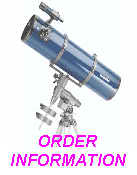
ITEMS FOR TRANSIT
SOLAR FILTER FILMS - (Specifically designed for Solar Filtration):
Black Polymer Solar Filter Film ($45AUD per 30 x 30cm - cut to any size).
- Stronger and lasts longer
- Plastic Film
- 1/1000 of 1% Transmission
- Sun appears an orange colour
Baader Solar Filter Film ($45AUD per 30 x 30cm - cut to any size).
- Finer, lasts around 3-5 years if stored
- Foil Film (similar to kitchen foil but stronger)
- Reduces intensity by 99.999%
- Sun appears a grey/blue colour
*Solar Eclipse Viewing Glasses ($3AUD each)*
Solar Filter caps which fit over the end of your telescope are available. Let us know your telescope diameter.
Sun Filter to suit 60mm telescopes/binoculars $64AUD
Sun Filter to suit 70-90mm telescopes/binoculars $92AUD
Sun Filter to suit 114-120mm telescope/binoculars $99AUD
Sun Filter to suit 130mm telescopes $112AUD
Sun Filter to suit 150-158mm telescopes $135AUD
Larger available
Inexpensive 1" (25mm) Huygen eyepieces $30AUD
Celestron's Range of Sun filters
Vixen Sun Diagonal Prisms (25.4mm) using Sun Glass
Celestron Binocular Sun Filters (2x 60-80mm filters)
Celestron Correction filters for those using Mylar #21 or #23A
Welding Glass No. 12-14 $10AUD
THE SUNSPOTTER
Your whole class can now observe and follow the storms that play havoc with our tiny globe! Sunspotter gives your students the opportunity to track sunspots as they appear, move and vanish. A bright 3" (76mm) solar image is projected in all its glory by the powerful (2.5") 62mm diameter objective lens. Students can easily trace the face of the Sun and compare it from hour to hour and day to day. Easily aligned to the Sun in Seconds, the Sunspotter makes our closest star a subject of study by even the youngest students, without the complication of telescopes, solar filters and tripods.
This unique, wooden, folded Keplerian telescope provides a much safer and convenient way to view the brilliant light of the Sun compared to more common methods. By using a series of mirrors, the device projects an image of the Sun onto a white viewing screen. Unlike other ways of viewing the Sun, the compact and sturdy Sunspotter is convenient, easy to set up, lightweight and fun to use.
The Sunspotter is also a great way to view solar eclipses in complete safety. Please inquire for more information and prices.

Black Polymer Solar Viewing Glasses $5AUD
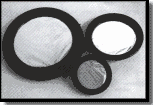
Telescope Solar Filters
PHILIPS ToUcam PRO II PCVC840K
ASTRONOMY WEB CAM
CCD CAMERA PLUS SOFTWARE FOR ASTRONOMY OR JUST A GREAT WEB CAM
NEW MODEL NOW AVAILABLE
The Philips ToUcam PRO II 840k PCVC840K digital camera/CCD Camera can be mounted onto a telescope to produce images on your PC of celestial objects and more. The camera has the ability of seeing in low light, without snowing, making it excellent for astronomy.
The ToUcam is featured in the June 2003 issue of 'Sky & Telescope' magazine and also the English 'Astronomy Now' magazine:
SKY & TELESCOPE MAGAZINE
ASTRONOMY NOW
Amateur astronomer using the ToUcam modified for long exposures:
ASH'S CHEAPO WEB CAMS
Effect of filters with the ToUcam:
DIETMAR HOERMANNSEDER'S ASTRO-PAGE
More web sites featuring images and information about the ToUcam:
GIORGIO MENGOLI
PAUL WHITMARSH
CLOUDY NIGHTS REVIEW
Philips ToUcam Pro II 840k CCD Camera plus software $230AUD
Adaptors to fit 1.25" telescope focusers are also available
$28AUD.
Adaptors threaded for for filters
$35AUD.
Filters are better suited to larger telescopes (8" and larger) when using the web cam. This depends on the brightness of the object.
5m Extension Cables
$24AUD$
This extends the total cable length to 7.7m. Please contact us for longer lengths.
Free Download Software for modifying the ToUcam astronomical images:
K3's ASTRONOMY PAGE
Information and technical data on the NEW Model Philips ToUcam PRO II PCVC840K can be seen here: http://www.philips.be/Assets/Downloadablefile/LF_840-2368.pdfInformation and technical data on the OLD Model Philips ToUcam PRO PCVC740K can be seen on here: http://www.consumer.philips.com/global/b2c/ce/catalog/assets/downloads/en_pcvc740k_lft.pdf
IR FILTERS FOR PHILIPS TO-U-CAM
$120AUDSince common light sources deliver light that has a very broad spectral output, reaching beyond the visible, many visual and detector-based applications call for a filter that is designed to pass only light within the visible spectrum. For example, monochrome (black and white) cameras are often used with IR cutoff filters to eliminate the effects of the presence of near infrared light incident upon the detector.
IR Blocking filters are 25mm diameter. It is a true dichroic filter and it is MgF2 coated.
2X BARLOW / CAMERA ADAPTOR / FILTER HOLDER
$70AUDBack in stock are these marvelous 1.25" diameter adaptors. They are able to do a number of things. Firstly, its a achromatic 2x Barlow. Secondly, its a camera adaptor, which is threaded, and only the T Mount is needed to suit your brand of camera. Photos can then be taken through a telescope at higher magnification without using an eyepiece. Thirdly, the Barlow's lens can be removed by unscrewing for true focal projection photography. Fourthly, with the Barlow's lens removed, filters can be screwed in. - Crikey!
COLOURED FILTER
*used with Solar Filter*
$30AUD
NO. 23A LIGHT RED
Moon - Enhances lunar features.
Mars - Reduces the light from the blue and green areas which darkens the maria, oases and canal markings while lightening the orangish desert regions. Also sharpens the boundries of yellow dust clouds.
Mercury - Improves observation at twilight when the planet is low near the horizon and in daylight it reduces the brightness of the blue sky to enhance surface features.
Saturn - Useful for studying the bluer clouds and the polar regions.
Venus - For daylight observing it reduces the brightness of the blue sky. Occasionally deformations of the terminator are visible.
Comets - Improves definition of comet dust trails.
Solar - When using Mylar Solar Filters, this filter will give you true colour rendition.
PAYMENT METHODS
- Electronic Transfer (Australia) Preferred Method
- Major Credit Cards ($5AUD or $3US$ Fee)
- Swift Transfer (International)
- Cheque
- Money Order (Australia)
- Cash
ELECTRONIC TRANSFER DETAILS:
Bank: PowerState Credit Union
Address: 147 Pirie Street, Adelaide SA 5000, Australia
Account No.: 00109743
Account Name: Telescopes and Astronomy
BSB No: 805001
SWIFT ELECTRONIC DETAILS
Bank: PowerState Credit Union
Address: 147 Pirie Street, Adelaide SA 5000, Australia
Account No: 1135601
Account Name: Telescopes and Astronomy
BSB No: 805001
Swift Code: CUSCAU2SXXX
(Please note - one number only in Swift Code)
Reference: "your name"
POSTAL ADDRESS
TELESCOPES & ASTRONOMY
PO BOX 292
O'HALLORAN HILL SA 5158
AUSTRALIA
EARTH
for schools

